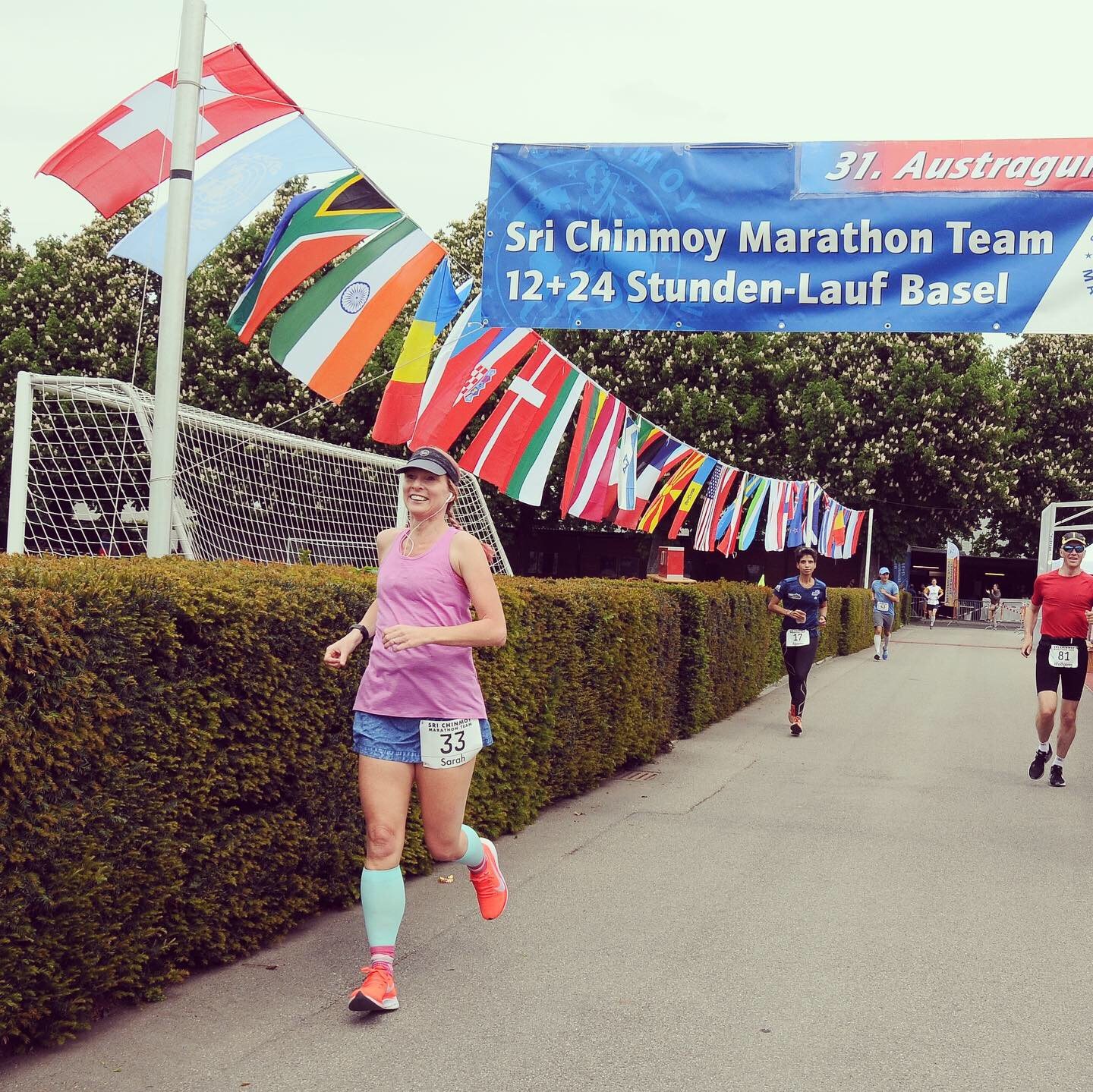Last year I ran my first 24 hour race, Crawley 24 hours. It was 24 hours of pure running joy and I loved every single minute of it. And the icing on the cake was that I’d done pretty ok at it, running 127.8 miles on my first attempt and achieving my A target, Spartathlon auto-qualification.
Some people can’t understand the appeal of 24 hour racing, but for me it’s the complete purity of this type of running. It’s just you, the track and the clock; it basically strips ultra running back to its simplest form.
I’d been quite adamant after Crawley that I wouldn’t be doing another 24 hour race for the foreseeable future, mainly because I think they take a massive toll on your body and I didn’t want to become obsessed with chasing arbitrary distances over 24 hours. However I’m also a big believer in doing things which make you happy. And running laps for a long time makes me happy. So by the end of the summer I was googling ‘24 hour races Europe’ and the seed of Basel was planted.
I learnt a lot in my first 24 hour race, and I believed that if I had another really good 24 hour race and improved in a couple of areas, at my best I could run about 130 miles.
However, the best laid plans don’t always work out.
I was really ill with anemia in the build-up to the race to the point that I was unsure if I’d even be able to make the start line. It’s hard to describe how debilitating anemia is if you haven’t suffered from it, but as a guide I was struggling to run in double figures at a very very slow pace before having to stop exhausted. Just 6 weeks before Basel, I had to cut a long 24 hour pace run short at 16 miles as I physically couldn’t run any longer, and I went home in tears to Tom saying ‘how can I even think about running a 24 hour race when I’m struggling to run 16 miles?’.
I had to drop Paris marathon and some other short races in the build-up and try and get my iron levels improved to a level that I’d be able to run Basel. This meant that I was unable to train as much as I’d have liked to, but Ian did an amazing job of working with my limitations and striking a balance between training and getting better. And 2 weeks before Basel, my latest blood tests showed I was no longer anaemic but still iron deficient, but I’d noticed in myself that running was starting to feel easier again, and I finally felt that I’d be able to make the Basel start line.
Prior to this I’d hoped to hit 210k at Basel, but as I didn’t know if my body would be strong enough to run for 24 hours, I decided my aim would be to just be the best I could be on the day, and if that meant I could only hit 100 miles or however far, then so be it, and I was just going to be happy and grateful that I was on the start line, and regardless of the result was going to enjoy the process.
As it turned out the race didn’t pan out at all how I was expecting; the highs exceeded any pre-race expectations I’d had, and the lows weren’t from any of the pre-race worries I’d feared.
So here’s what I learnt from running for 24 hours (part 2).
Leave any ego on the start line and get comfortable with running really slowly
Until you’ve witnessed a 24 hour race close up, it’s hard to describe the carnage that follows with people going off too fast. It’s the same as at all ultras, but you don’t get to witness it first hand in a point to point race like you do when running laps. ‘Running slowly’ is obviously a relative term, but as a guide my starting 24 hour pace on the flat is about 2:30 minutes slower than my MP. It’s that slow and easy. And I have enough confidence in my running and race plan to not care if I’m near the back of the field in the early hours. In fact, if I was placing highly early on then I know I’d gone off too fast.
I had no idea where I was in the standings in the first few hours (just the top 7 male and female were put on a board) and to be honest, I had no expectations for finish position as it was an incredibly strong female line-up with a number of runners who run for their national teams, including Maria Jansson (the 24 hour European Champion gold medalist and World Champion bronze medalist) and Nele Alder-Baerens (the second fastest woman in the world ever over 100 miles, although it was announced before the race start that Nele was just going to target the 12 hour world record – which she achieved and was an absolute privilege and masterclass to witness).
The race uses chip lap counting but there’s also manual counters as back-up who are the most enthusiastic encouraging cheer squad every time you pass them for the full 24 hours, and after about 6 hours they gave me an even bigger cheer and pointed to the leader board to show that I’d moved into 7th place.
I continued my upwards trajectory throughout the race so that after 20 hours I’d moved into 2nd place, however when I had to call it a day at 21:06 hours, and 3rd and 4th place continued, I eventually finished 4th. And that was all down to running slowly.
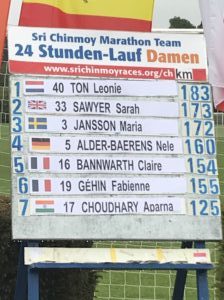
Have a race plan but ultimately run to feel
I practice my 24 hour pace a lot in training so I knew what effort I’d hope to mostly be running, but I also knew that if at any point it started to feel too hard then I’d back off the pace a bit. Based on my Crawley performance I knew where I’d been at 50 miles, 12 hours and 100 miles, so was going to use that as a rough guide as to where I was in comparison. Running watches are notoriously inaccurate on tracks so I’d paid no attention to what my Garmin was telling me at Crawley. However, as it was a larger loop (1.2km) at Basel, I was expecting my Garmin to be more accurate, however there was a lot of tree cover on one side of the park so my Garmin was out every lap so I ignored what it was telling me and just ran to feel.
It wasn’t until afterwards and I saw the official results that I went through 50 miles at 8:09 (vs 8:20 at Crawley) and 12 hours in 72.1 miles (vs 70.5 miles at Crawley) – I felt like I was running well and it was one of those running days where everything was feeling easy and the miles and hours were flying by.
Learn to convert miles to km!
I work in miles but 24 hour races work in km, which does nothing to help my frazzled brain when I’m running long distances! I thought I was going to be on track for a very small 100 mile PB (my current PB was 17:36), however I was basing my sums on 100 miles = 165km. I knew it was going to be tight so I didn’t even dare go for a toilet stop as I closed in on 100 miles, however Tom at track side was doing the sums and told me I only had 2km to go to hit 100 miles (I know now 100 miles = 161km!) and I hit a new 100 mile PB in 17:13:56 (average 10:19 pace) which was totally unexpected and beyond my wildest dreams. If I am having a good race I know the second half of a 100 miler should be about an hour slower than the first half, and this was pretty much spot on with a 8:09 first 50, followed by a 9:04 second 50. The main thing was I still felt pretty good; ok I felt like I’d run 100 miles in the fastest time I’d ever run it in, but I definitely felt like I could keep on going for several more hours.
Get your nutrition right
One area where I knew I could improve on Crawley was my nutrition. I’ve always struggled to eat and digest solid foods in a race, so I’ve taken them completely out the mix now. So liquid calories and soft food was the order of the day and I had a simple nutrition plan where I’d take a Mountain Fuel Jelly or GU gel every 30 minutes and then something more substantial on the hour, either a Longhaul Endurance food pouch or an Ambrosia custard pot. I drank Mountain Fuel Energy drinks throughout and a Mountain Fuel Recovery shake every 4 hours. After about 16 hours I mainly moved completely onto Jelly’s/gels and liquid calories and I had some emergency Maurten drink mix which gave 320 calories a pop. There’s no right or wrong answer to nutrition – sports drinks, Jelly’s, savoury food pouches and custard might not work for everyone, but after many years of trial and error, I know what works for me now.
It’s ok not to run with a big smile on your face all the time
Before the race I was determined to run happy and just be grateful for the fact I was racing. I’d described Crawley as 24 hours of running joy, so I had no reason to think that Basel wouldn’t be the same. However, I was really lucky at Crawley in that nothing at all went wrong, however Basel brought about a few more challenges. Firstly in the first few hours I was plagued with really bad stomach ache (this is a side effect to the strong iron tablets I am taking) and I had to make four emergency toilet stops in the first four hours, which wasn’t boding well for the race if I was going to have to spend so much time on the toilet! However, Tom gave me a mix of Pepto Bismol, Alcaseltzer and a rehydration drink which managed to settle my stomach and from then onwards I had no stomach issues and my big smile returned.
I also had horrendous chafing which I never normally suffer with, but was probably due to the fact we had torrential rain overnight; however apart from liberal application of chafing cream, I knew I’d just have to woman up, but I won’t begin to describe the pain when I needed to go the toilet!
Both those challenges were managed though, however with just over 4 hours to go my left knee became so swollen I could barely bend it or lift my leg. Tom had assumed many roles during the day and now he needed to get his doctor head on, so he gave me paracetamol, put Ibuprofen gel on it and strapped it up. I’ve never had any issues in my knees before, and the only thing I think which could explain it was that the course had been amended so each lap had a bit of a camber with a short uphill and downhill and I think I was inadvertently pushing a bit hard on the downhill, and the repetitive nature of this every lap caused my quads to overwork. I sent my physio a picture of the knee after the race and she agreed that it looks like a swollen bursa originating from the quads, which fortunately will just need ice, rest and compression.
I realised that I was unable to run anymore, but worked out that as long as I could maintain 20 minute walking mile pace in the time left them I’d hit 200k. I walked the next 3 miles but my knee was becoming more and more painful. Tom came to walk with me on one lap and said he’d never tell me what to do, but to remember I’d got nothing to prove by continuing, I’d already surpassed anything I thought I’d achieve pre-race, so if my knee was that painful then it was ok to stop.
I knew he was right, the last thing I wanted to do was make it worse by walking for another 3 hours dragging my leg along with me, just to hit an arbitrary figure of 200k. So at 21:06 hours and with 185.712km/115.06 miles on the clock, I called it a day, totally happy with my decision and how the first 110ish miles had gone.
So it definitely wasn’t the 24 hours of running joy I’d experienced at Crawley; there was a lot of running joy, and the counters kept laughing and telling me that I was the happiest smiliest runner in Basel, but there were a few low non-smiley points. But that’s the nature of ultra running, and normally if you deal with them, they’ll pass.

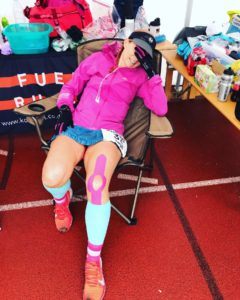
Races over 100 miles are a bit too long!
Up until 100 miles I’d pretty much enjoyed most of the race, however at both Crawley and at Basel, I started to find things a bit of a slog after 100 miles, especially when it’s got light again. I don’t know if this is physical or psychological, or maybe it’s just that 100 miles is more than enough for one pair of legs to run in any one go! However, with Spartathlon, my next big race clocking in at 153 miles and where I’m going to be running for over 30 hours, this is something I definitely want to improve on with Ian. Or hope that maybe Spartathlon gets shortened to finish at 100 miles at the mountain!
Your crew is the most wonderful thing
I said prior to the race that I had the easier job running for 24 hours, whereas Tom had the much harder job and his roles included drinks maker, food provider, first aider, mathematician, photographer and social media guru, so he definitely had his work cut out! I normally travel really light for races and have run 100 miles without a drop bag, however I went the other way this time and made sure all eventualities were covered to the point that we ended up taking more luggage for a weekend to Basel than we do on a two week holiday!
I’ve never changed trainers in a race but wasn’t sure if the Nike Vaporfly 4% would work for the full 24 hours so I had two pairs of Hokas as back-up, however as it turned out the Vaporfly were perfect and my feet come away completely unscathed. After seeing the legend that is Cat Simpson end up having to run in a down jacket at Crawley this year after it became so cold overnight, I took plenty of warm gear. However we were blessed with pretty perfect conditions, a high of 20 degrees in the day and not dropping down to single figures at night. It did rain pretty much continuously overnight but I very rarely run in a waterproof as I find I get too warm, however when I had to revert to walking in the final few miles I felt my body temperature drop so I put lots of extra layers on, and if I’d continued for much longer I would probably have started taking Tom’s clothes off his back!
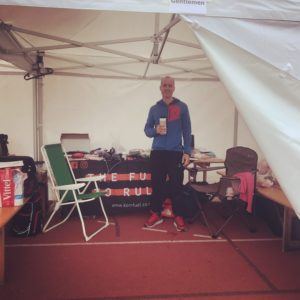
Have a target but don’t be fixated on it
I’ve seen a lot of people go into 24 hour races with a specific target and then when they know they are going to fall short of it, give up. Both times I had a target so that if it got to 4am in the morning and I started to question what on earth was I doing running round a track/loop for 16 hours with 8 hours to go, I’d remember my reasons for doing so, but it was never my main motivation. My main motivation for running for 24 hours is simply enjoyment. As long as we are the best that we can be on any particular day, then we can’t ask for anymore. And 115 miles was as good as I was on 18/19 May 2019, and when my knee stopped play I couldn’t do any more which is why I’m totally happy with what I achieved.
Post-race thoughts
On paper it might look like a massive step backwards only running 115 miles at Basel vs the 127.8 miles I ran at Crawley, however the way I feel this couldn’t be further from the truth for me. If someone had told me pre-race, with the rocky build-up leading up to it, that I’d finish with 115 miles, a 100 mile PB of 17:13 and 4th female, I would have snapped their hand off. The knee was unfortunate but just one of those things and seeing how swollen it is, I’m so glad that I had the sense to stop when I did.
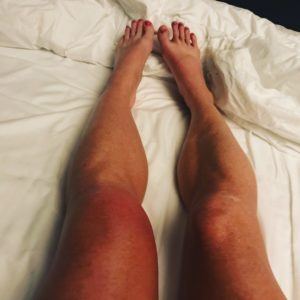
I’ve run many types of races over the years but I stand by my statement that 24 hour races are the hardest of the lot (ok I’m pretty sure Spartathlon will soon take over that accolade!) – I don’t struggle with the mental side at all of them, but I find the relentless repetitive nature of them on the body really does take its toll. I was talking to Michael Stocks at the start (who was just using Basel as a 12 hour or 100 mile training run ahead of his first GB 24 hour appearance at the World Championships later this year) and we both agreed that 1 x 24 hour race a year is quite enough!
So I’ll definitely give 24 hour racing another shot in 2020 as I genuinely love the concept of it and I feel I’ve got a bit of unfinished business with them after this year, so I think that Desert Solstice is calling me in 2020 as I’ve got the qualification standard for it.
Thank you so much to Ian for a being such an amazing coach and support – I always say it’s easy to be a good coach when everything is going well in your running but you see what a really good coach is when they’re there through the bad times….and believe me there have been a lot of bad times over the last 6 months!
Thank you to Mountain Fuel, Longhaul Endurance and Likeys for their continued support. Thank you also to Dawn and Emily for keeping my legs in working order.
And the biggest thank you to Tom, I couldn’t do half this stuff without his support – now it’s my turn to repay the favour next week at his GUCR!
